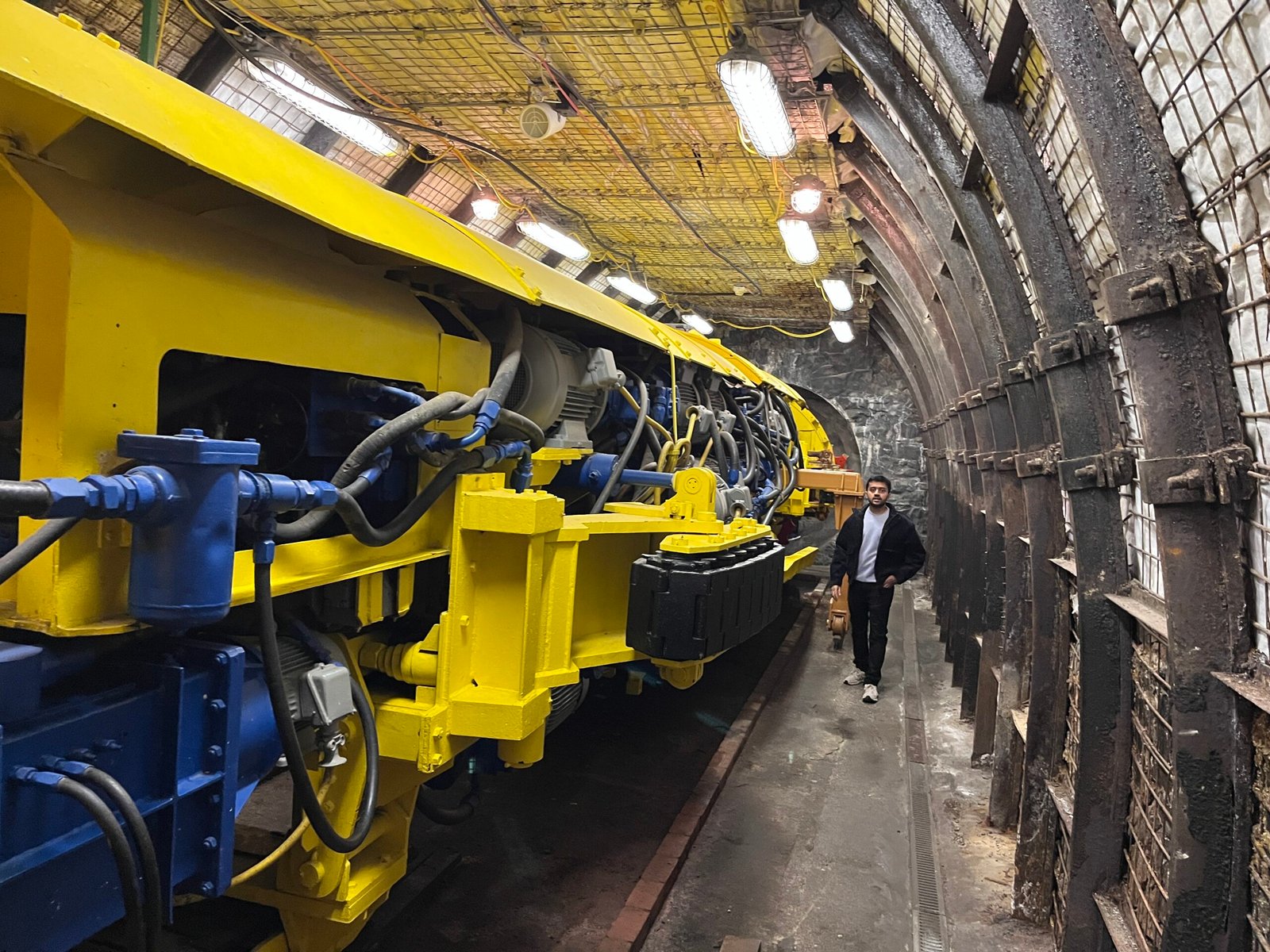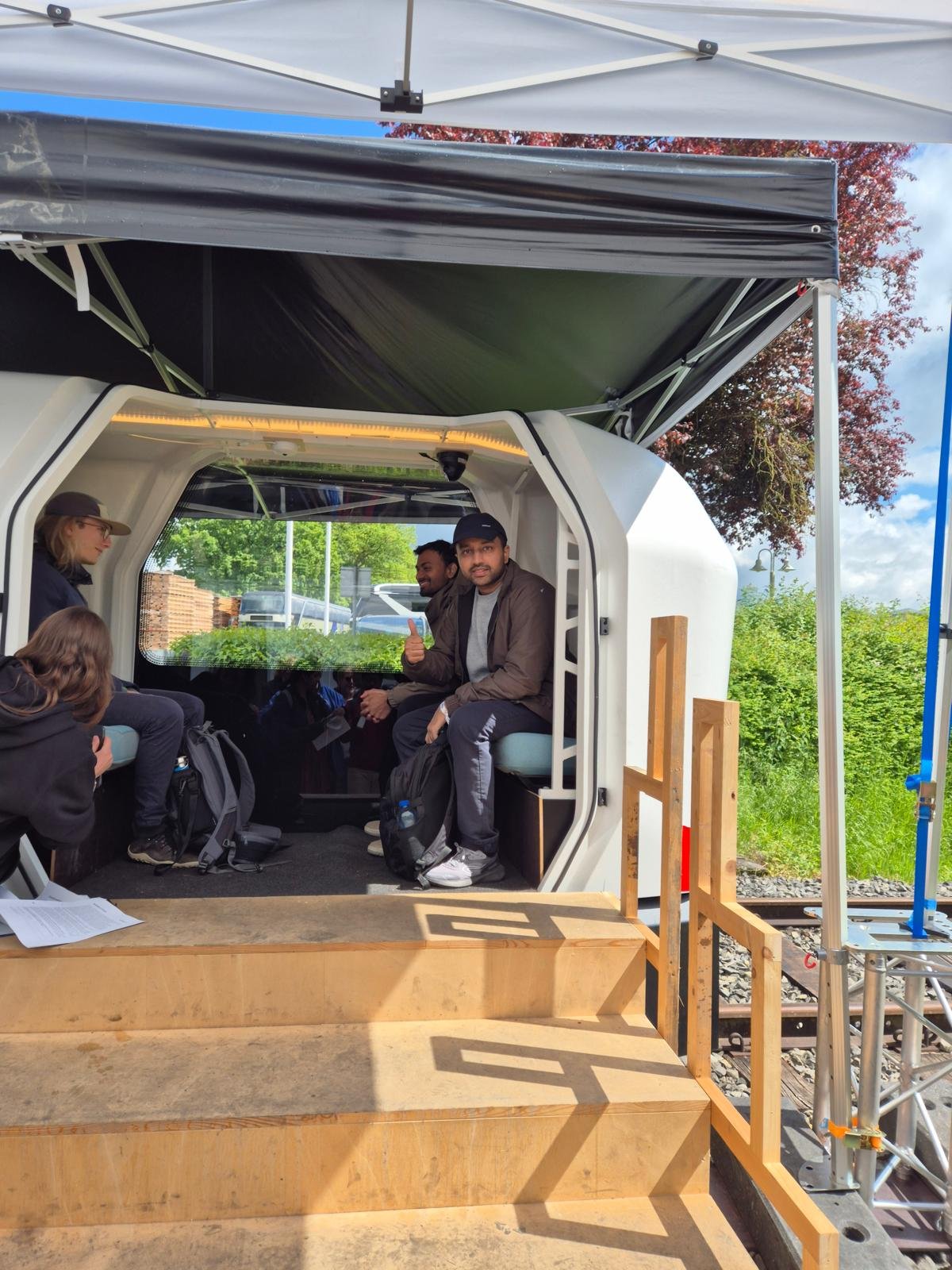At first glance, the stairwell felt like any other in a museum — quiet, functional, leading to another exhibit. But three levels beneath the surface of the Deutsche Bergbau-Museum in Bochum, Germany, the space changes. It cools. Sounds soften. The lighting dims. And then the environment shifts altogether. You’re not in a typical gallery anymore. You’re underground!



The museum’s lower level recreates the experience of walking through a mine. Steel beams frame the tunnels, old equipment lines the walls, and the air carries an industrial weight. These aren’t just sets; they are full-scale replicas meant to reflect the underground spaces that once supported an era of coal and ore extraction. But among the historic artifacts and mining gear, one object stands apart — larger, newer, and still bearing the marks of heavy use.


It’s a Tunnel Boring Machine (TBM) cutterhead, retired from duty and placed on display. Circular, made of solid steel, and lined with rugged cutting discs, it commands attention even in stillness. It’s something designed to push through the Earth itself — carving through layers of rock, clay, or sand to make space for the tunnels beneath our feet.
The Function and Anatomy of a Tunnel Boring Machine
A Tunnel Boring Machine is not a single-purpose tool. It’s a complex, multi-part system engineered to perform several jobs at once — excavating, transporting spoil, stabilizing the tunnel face, and lining the tunnel as it progresses. Though “machine” is used in the singular, a TBM is better described as a mobile tunnel construction plant.

At the front is the cutterhead, the massive circular component visible in the museum. This rotates against the tunnel face, breaking up material using specially shaped tools — discs in the case of hard rock, scrapers or picks in softer ground. Immediately behind the cutterhead is a chamber where the material is collected, crushed, and passed backward through conveyors or slurry pipelines, depending on the type of TBM.

Then come the systems for tunnel lining. Most modern TBMs install precast concrete segments as they move forward, creating a finished tunnel wall almost immediately after excavation. These lining segments are positioned by mechanical arms known as segment erectors. As the tunnel advances, hydraulic jacks at the rear of the TBM press against these segments to push the entire machine forward.

TBMs often span over 100 meters in length, with the largest extending up to 400 meters. They include power systems, cooling systems, ventilation ducts, control cabins, emergency shelters, and even rest areas for crews. In projects where access to the surface is limited or the tunnel stretches for many kilometers, these features ensure the crew is safe and have everything to live underground for a significant period of time.

Tailor-Made Machines for Unique Challenges
What distinguishes TBMs from most other construction equipment is that they are always customized. There’s no “standard” TBM. Each one is built or adapted specifically for the geological conditions and engineering requirements of the project it’s designed to serve.
In soft, urban soils — like clay or silty sand — Earth Pressure Balance (EPB) TBMs are often used. These maintain pressure at the tunnel face using the excavated material itself, preventing ground collapse and surface settlement. In more water-saturated or loose soil conditions, Slurry Shield TBMs are deployed. These mix the excavated material with a bentonite slurry, keeping everything stable and helping transport spoil out of the tunnel as a liquid.

Designed to navigate soft ground and high groundwater conditions beneath one of Europe’s densest cities, this EPB TBM maintained constant pressure at the tunnel face — minimizing surface disruption while tunneling safely below historic buildings and narrow streets. (Photo source: here)
For solid rock environments — such as tunnels through mountain ranges — Hard Rock TBMs are used. These are equipped with heavy-duty disc cutters, often made from tungsten carbide, capable of grinding through granite, basalt, or other strong formations. In high-pressure zones, these TBMs are built to withstand intense geological stress, often operating with double-shield systems to handle both excavation and lining simultaneously.

Engineered to cut through some of Europe’s toughest Alpine geology, this TBM used high-strength disc cutters to grind through granite and gneiss over 57 kilometers. Its precision and endurance helped complete the world’s longest railway tunnel under extreme underground pressure and temperature conditions. (Photo source: here)
Every TBM is fabricated to fit the tunnel diameter required for the project. This can range from compact microtunneling machines — just 1 meter in diameter — to colossal machines over 17 meters wide. One of the most famous examples is Bertha, the TBM used in Seattle to dig a highway tunnel beneath the city. Bertha’s cutterhead was 17.5 meters in diameter, making it one of the largest ever constructed. It dug beneath downtown Seattle, under existing infrastructure, without causing surface disruption.
Inside the Machine: Life on the Move
On larger projects, the machines include cabins and rest areas for engineers and tunnel workers. Control rooms inside the TBM are filled with screens showing data from dozens of sensors monitoring cutterhead torque, alignment, temperature, and ground pressure. Ventilation systems supply fresh air deep underground, while fire suppression systems and escape tunnels offer safety measures in case of emergencies.

Located deep within the machine, the control room is the TBM’s nerve center. Operators monitor ground pressure, cutterhead torque, machine alignment, and excavation progress in real time — ensuring safe, continuous tunneling beneath cities, rivers, or mountains, often 24 hours a day. (Photo source: here)

Crews work in rotating shifts to keep the machines running 24 hours a day, seven days a week. Progress might be slow — often just 10 to 20 meters per day — but it’s steady. Some machines advance less than a meter per hour, but over months and years, that pace creates the infrastructure cities depend on for generations.
Does India have its own TBM’s?
Yes. India now manufactures its own Tunnel Boring Machines, reducing the need for costly imports. Public sector company BEML Limited and private firms like Tata Projects and L&T have developed TBMs tailored for Indian geology, which often includes a mix of hard rock, clay, and loose soil. These machines are designed to handle challenges such as high groundwater levels and variable ground conditions found in many metro and infrastructure projects.

Indian-made TBMs have been deployed in major works including the Mumbai Metro, Delhi Metro, Bengaluru Metro, and water supply tunnels in states like Maharashtra and Andhra Pradesh. Building TBMs domestically not only cuts project costs but also supports faster delivery and easier maintenance, as spare parts and expertise are available within the country. It also strengthens India’s engineering capabilities, allowing local teams to design, customize, and upgrade machines for future projects.
What Happens After Tunneling?
When a TBM finishes its job, its future depends on the project design. If possible, the machine is disassembled and removed from the tunnel in reverse. In many deep or long tunnels, however, disassembly isn’t practical. In those cases, the TBM is simply entombed at the tunnel’s endpoint, sealed behind permanent walls — a forgotten but essential part of the structure it helped create.

Only a few cutterheads are ever brought back to the surface, cleaned, and preserved for public display. That’s why seeing one at the Bergbau-Museum is such a rare and valuable opportunity — especially for anyone with an interest in engineering or infrastructure.
A Machine less appreciated
There are no grand opening ceremonies for tunnel boring machines. No daily updates in the news. But these machines are always working — beneath rivers, through hills, under neighborhoods — turning slowly, safely, and steadily. Their job isn’t to be seen. It’s to create space where none existed.
Subways, storm drains, fiber-optic routes — all shaped by machines like the one resting in that underground room. The cutterhead might be still now, but somewhere else, one just like it is turning again — building the invisible framework of the modern world.





Leave a Reply